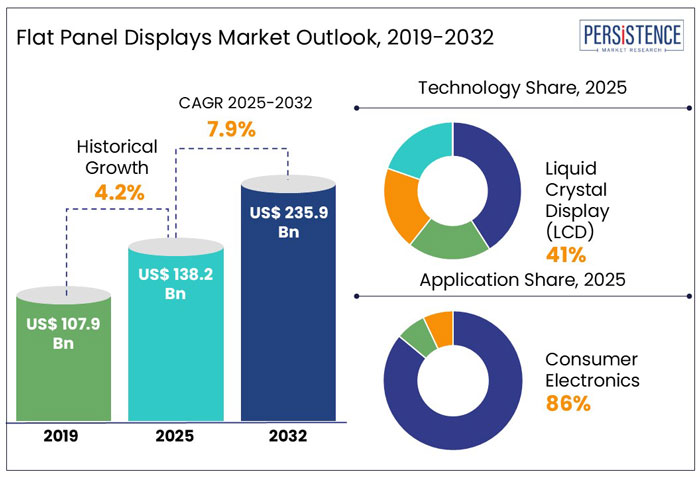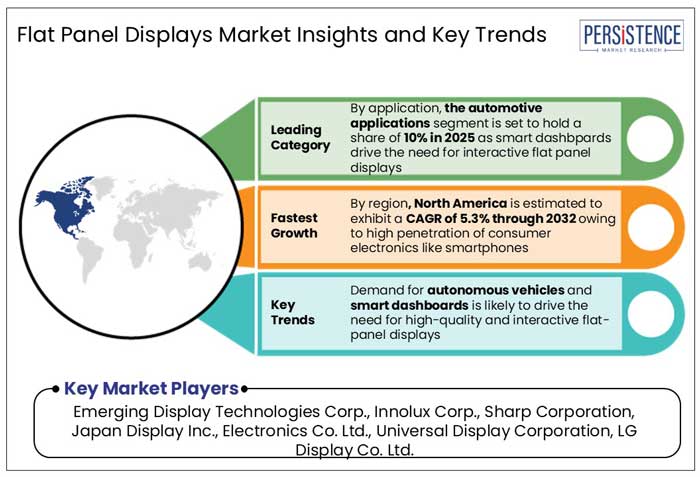Industry: Semiconductor Electronics
Published Date: February-2025
Format: PPT*, PDF, EXCEL
Delivery Timelines: Contact Sales
Number of Pages: 189
Report ID: PMRREP12943
The global flat panel displays market is predicted to reach a size of US$ 138.2 Bn by 2025. It is anticipated to showcase a CAGR of 7.9% during the forecast period to attain a value of US$ 235.9 Bn by 2032.
OLED and micro-LED displays are estimated to witness substantial growth as these offer superior contrast ratios, faster response times, and energy efficiency. OLED displays, in particular, are gaining traction in smartphones, televisions, and wearables owing to their ability to deliver vibrant colors and deep blacks.
Mini LED displays are gaining traction in premium televisions and monitors as these use a smaller LED array to improve the backlighting of LCD panels. Coupled with quantum dot technology, these displays offer improved brightness, color accuracy, and energy efficiency. For example,

Key Highlights of the Industry
|
Market Attributes |
Key Insights |
|
Market Size (2025E) |
US$ 138.2 Bn |
|
Projected Market Value (2032F) |
US$ 235.9 Bn |
|
Global Market Growth Rate (CAGR 2025 to 2032) |
7.9% |
|
Historical Market Growth Rate (CAGR 2019 to 2023) |
4.2% |
North America flat panel displays market is estimated to hold a share of 43% in 2025. The region, especially the U.S. is home to few of the leading technology companies, research institutions, and innovation hubs. This drives the development of OLED, micro-LED, and QLED displays.
High penetration of smartphones, televisions, gaming monitors, and wearable devices in North America contributes to the region's leadership. The market for smart TVs with flat panel displays in North America is driven by consumer preferences for high-quality home entertainment experiences.
North America’s robust automotive sector including manufacturers like Tesla, General Motors, and Ford is increasing the adoption of innovative flat panel displays. Widespread adoption of digital signage for advertising in retail, transportation, and public spaces is a prominent growth driver in the region.
Liquid crystal display (LCD) is projected to hold a share of 41% in 2025. LCD technology is more cost-effective compared to other display technologies like OLED and micro-LED. The well-established manufacturing infrastructure for LCD panels enables economies of scale, thereby decreasing production costs. For example,
Smartphones, televisions, computer monitors, and automotive displays use LCD technology owing to their ability to offer high-resolution displays at affordable prices.
Innovations in In-Plane Switching (IPS) technology and Mini-LED backlighting have significantly enhanced LCD performance. These have helped improved brightness, contrast ratios, and viewing angles.
The consumer electronics segment is anticipated to hold a share of 86% in 2025. Increasing demand for high-resolution displays in smartphones and tablets is a primary driver of flat panel displays. For example,
Flat panel displays are the standard technology for smart TVs, driven by consumer preferences for ultra-high-definition (UHD) and 4K/8K resolution.
Rising popularity of wearable electronics like smartwatches and fitness trackers drives demand for compact and energy-efficient displays.
Potential growth in the global flat panel displays industry is predicted to be driven by rising adoption of 8K displays with developments in content production and broadcasting technologies. OLED and mirco-LED displays are estimated to gain significant share owing to developments in AR/VR and automotive applications. The industry is predicted to adopt eco-friendly manufacturing practices and energy-efficient technologies.

The flat panel displays market growth was steady at a CAGR of 4.2% during the historical period from 2019 to 2023. Adoption of OLED technology witnessed a significant rise during this period, particularly in smartphones and premium TVs. For instance,
Mini-LED and micro-LED technologies gained traction for their superior color contrast and energy efficiency, especially in gaming monitors and high-end televisions. Rising smartphone sales, shift to smart TVs, and increasing adoption of wearables drove growth. For instance,
Growth in the forecast period is likely to be driven by the high popularity of video streaming services and smart home technologies. The period is likely to witness increased demand for large-screen TVs with high-definition displays.
Rising Adoption in Healthcare Sector
Flat panel displays are integral to unique diagnostic equipment like MRI, CT scans, and digital X-ray systems. Surgeons rely on flat panel displays for minimally invasive surgeries, which require high-definition imaging for precision. For instance,
Rise of telemedicine has led to a surging need for display technologies that facilitate high-quality video consultations and data sharing. Integration of flat panel displays in monitoring devices provides real-time visualization of critical health parameters.
Surging Applications in Industrial Settings
FPDs are widely used in industrial control systems for visualizing production processes and equipment diagnostics. For example,
As industries adopt smart manufacturing practices, there is a rising demand for interactive flat panel displays for machine operation and monitoring.
Displays are used for real-time tracking, operational monitoring, and vehicle navigation systems in logistics and transportation hubs. The logistics display solutions market witnessed a 14% CAGR from 2019 to 2023, supporting FPD growth.
High Energy Consumption in Manufacturing
One of the most energy-demanding stages in flat panel display manufacturing is the synthesis and processing of materials, especially for OLED and LCD screens. For LCD displays, the glass substrates are heated to high temperatures during the coating process, which requires substantial energy inputs.
In the case of OLEDs, energy is needed not only for the glass but also for the organic materials used to produce the light-emitting layer. OLED panel production requires clean rooms, high vacuum environments, and precise deposition processes, all of which are energy intensive.
Assembly process, which includes LCD backlighting, pixel formation, and thin-film transistor (TFT) manufacturing, also demands a significant amount of energy. Thin-film transistor (TFT) LCD displays, the most common type of display used in TVs and monitors, require extensive energy to ensure precision in pixel alignment and color rendering.
Shift to High-resolution Displays Like 4K and 8K
Increasing availability of native 4K and 8K content across streaming, gaming, and professional media sectors is propelling growth. Innovations in OLED, QLED, and MicroLED technologies have made high-resolution displays more energy-efficient and cost-effective. Retail and outdoor advertising sectors are adopting 4K and 8K displays for impactful content delivery. For example,
Adoption of HDMI 2.1 and DisplayPort 2.0 technologies, supporting 8K resolutions and high refresh rates are spurring demand. High disposable income and the trend toward home theater systems are driving consumer preference for 4K and 8K displays. High-resolution displays are increasingly essential for diagnostic imaging, radiology, and surgical procedures. For instance,
Boom of Smart Home and IoT Devices
Flat panel displays have become central hubs for controlling other smart devices through virtual assistants like Alexa, Google Assistant, and Siri. For instance,
Smart displays embedded in home energy management systems help monitor and optimize energy usage, aligning with the global push for energy efficiency.
Displays are now integrated into video doorbells, surveillance systems, and intercoms, providing homeowners with enhanced visual control and security features. For instance,
Companies in the flat panel displays market are investing in developing novel display technologies like OLED, microLED, miniLED, and Quantum Dot displays to deliver high resolution, better energy efficiency, and superior image quality. LG Display launched its OLED EX technology, offering 30% brighter displays with enhanced color accuracy, gaining traction in premium TV markets.
Businesses are collaborating with technology companies and component manufacturers to enhance display performance and decrease production costs. Apple partnered with BOE Technology for the supply of advanced OLED displays for its smartphones.
Organizations are increasing their production capacity to meet the rising demand for flat panel displays, especially in sectors like consumer electronics and automotive. BOE Technology Group announced an investment of US$ 7.5 Bn to build a new LCD and OLED production facility in China.
Recent Industry Developments
|
Attributes |
Detail |
|
Forecast Period |
2025 to 2032 |
|
Historical Data Available for |
2019 to 2023 |
|
Market Analysis |
US$ Billion for Value |
|
Key Regions Covered |
|
|
Key Market Segments Covered |
|
|
Key Companies Profiled in the Report |
|
|
Report Coverage |
|
|
Customization and Pricing |
Available upon request |
By Technology
By Application
By Region
To know more about delivery timeline for this report Contact Sales

The market is anticipated to reach a value of US$ 235.9 Bn by 2032.
Liquid Crystal Display (LCD) and Plasma Display (PDP) are the two types.
North America is anticipated to emerge as the leading region with a share of 43% in 2025.
Prominent players in the market include Emerging Display Technologies Corp., Innolux Corp., and Sharp Corporation.
The market is predicted to witness a CAGR of 7.9% throughout the forecast period.